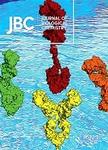版权所有:内蒙古大学图书馆 技术提供:维普资讯• 智图
内蒙古自治区呼和浩特市赛罕区大学西街235号 邮编: 010021

作者机构:Boehringer Ingelheim Canada Ltd Dept Chem Bio Mega Res Div Laval PQ H7S 2G5 Canada Boehringer Ingelheim Canada Ltd Dept Biol Sci Bio Mega Res Div Laval PQ H7S 2G5 Canada
出 版 物:《JOURNAL OF BIOLOGICAL CHEMISTRY》 (生物化学杂志)
年 卷 期:1999年第274卷第26期
页 面:18618-18624页
核心收录:
学科分类:0710[理学-生物学] 071010[理学-生物化学与分子生物学] 07[理学]
主 题:腺苷三磷酸酶类/代谢 氨基酸序列 肝炎病毒属/代谢 配体 磁共振波谱学 模型 化学 模型 分子 分子序列数据 蛋白质构象 RNA解螺旋酶类/代谢 丝氨酸内肽酶类/代谢 溶液 病毒非结构蛋白质类/代谢
摘 要:The interactions of the NS3 protease domain with inhibitors that are based on N-terminal cleavage products of peptide substrates were studied by NMR methods. Transferred nuclear Overhauser effect experiments showed that these inhibitors bind the protease in a well defined, extended conformation. Protease-induced line-broadening studies helped identify the segments of inhibitors which come into contact with the protease. A comparison of the NMR data of the free and protease-bound states suggests that these ligands undergo rigidification upon complexation. This work provides the first structure of an inhibitor when bound to NS3 protease and should be valuable for designing more potent inhibitors.